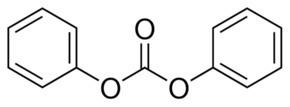Formula C13H10O3 Melting point 83 °C Density 1.12 g/cm³ | Molar mass 214.216 g/mol Boiling point 306 °C | |
 | ||
Diphenyl carbonate is an acyclic carbonate ester. It is both as a monomer in combination with bisphenol A in the production of polycarbonate polymers and a product of the decomposition of polycarbonates.
Contents
Production
World production capacity of diphenyl carbonate was 254,000 tonnes in 2002, and phosgenation of phenol is the most significant route. Phosgenation of phenol can proceed under various conditions. The net reaction is as follows:
2 PhOH + COCl2 → PhOCO2Ph + 2 HClThe use of toxic phosgene can be avoided by the oxidative carbonylation of phenol:
2 PhOH + CO + [O] → PhOCO2Ph + H2ODimethyl carbonate can also be transesterified with phenol:
CH3OCO2CH3 + 2 PhOH → PhOCO2Ph + 2 MeOHThe kinetics and thermodynamics of this reaction are not favorable For example, at higher temperatures, dimethyl carbonate undesirably methylates phenol to give anisole.
Applications
Polycarbonates can be prepared by transesterifying diphenyl carbonate with bisphenol A, and phenol is a co-product. Phosgene is avoided as a result. These polycarbonates may be recycled by reversing the process: transesterifying the polycarbonate with phenol to yield diphenyl carbonate and bisphenol A.
